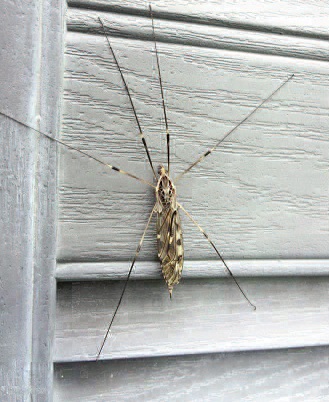Identifying oversized mosquitoes
by Roland D. Hallee
Have you ever gone to bed on a warm summer night, and seen this thing flying around that resembles a large mosquito?
It happens to me all the time at camp.
Sitting up in bed, grabbing the book I’m reading, or possibly a magazine for some light and quick reading. And, there it is, buzzing around the light, and becoming extremely annoying. It looks like a giant mosquito.

A crane fly.
One of my relatives recently posted a photo on Facebook of that exact same insect on her arm. In the posting, she notes, “it’s a good thing I’m not afraid of spiders.” Wait a minute, this insect has six legs. All arachnids have eight legs. That is not a spider.
Well, I quickly fired off an email to my biologist contact at the Maine Department of Inland Fisheries and Wildlife, along with the photo. It didn’t take long to receive a reply.
His response was, “this is a cranefly, a true fly in the order Diptera, and probably from the family Tipulidae. There are over 1,500 species of Craneflies in North America and possibly several hundred in Maine. The adults are harmless, some species not feeding at all, and some species feeding predominantly on nectar.”
In colloquial speech, the cranefly is sometimes called Daddy Longlegs, a term also used to describe opiliones, or harvestmen, both of which are arachnids. The larvae of the cranefly are known commonly as leatherjackets.
Craneflies are found worldwide, though individual species usually have limited ranges.
The adult crane fly, like mentioned earlier, resembles an oversized mosquito, and has stilt-like legs that are deciduous, easily coming off the body.
The adult female usually contains mature eggs as she emerges from her pupa, and often mates immediately if a male is available. Adult craneflies have a lifespan of 10 – 15 days. Cranefly larvae (leatherjackets) have been observed in many habitat types on dry land and in water. They are cylindrical in shape, but taper toward the front end, and the head capsule is often retracted into the thorax. Larvae may eat algae, microflora, and living or decomposing plant matter, including wood. Some are predatory.
Some lavae species consume some living aquatic insects and invertabrates, which could potentially include mosquito larvae. Many, however, because of their short lifespan, never eat at all.
Despite widely held beliefs that adult crane flies prey on mosquito populations, the adult crane fly is anatomically incapable of killing or consuming other insects.
Crane flies are generally thought as agricultural pests. Since the late 1900s they have become invasive in the United States. The larvae have been observed on many crops, including vegetables, fruits, cereals, pasture, lawn grasses and ornamental plants. It is harmless to humans, can be a nuisance to agriculture, but I wish it would stop reading over my shoulder.
Responsible journalism is hard work!
It is also expensive!
If you enjoy reading The Town Line and the good news we bring you each week, would you consider a donation to help us continue the work we’re doing?
The Town Line is a 501(c)(3) nonprofit private foundation, and all donations are tax deductible under the Internal Revenue Service code.
To help, please visit our online donation page or mail a check payable to The Town Line, PO Box 89, South China, ME 04358. Your contribution is appreciated!


Leave a Reply
Want to join the discussion?Feel free to contribute!